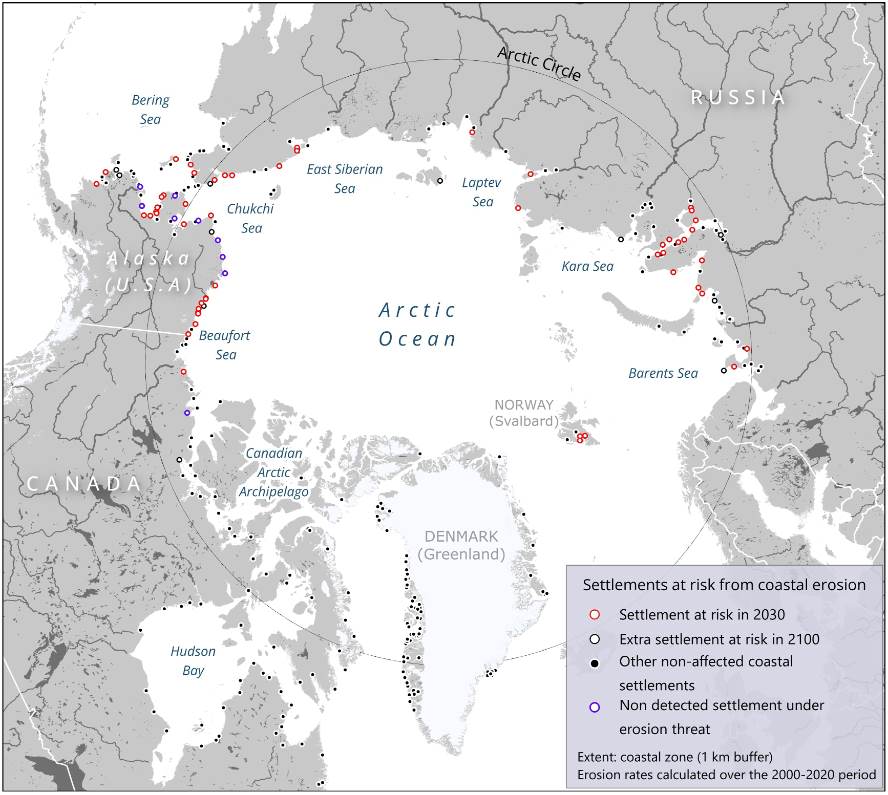Coastal communities and infrastructure across the Arctic are under severe threat from erosion, sea level rise, and permafrost thaw, according to the first comprehensive pan-Arctic assessment of climate risks to the region.
The findings, published in Earth’s Future, project significant damage to settlements and infrastructure by the end of the century, with widespread implications for the Indigenous communities and industries reliant on these regions.

The study revealed that by 2100, 21% of Arctic settlements along permafrost coasts could be damaged by erosion, 45% could be affected by rising sea levels, and 77% of infrastructure may rest on unstable, thawing ground. Erosion, currently the most significant threat, is already reshaping coastlines, with some areas experiencing retreat rates of up to 20 meters (67 feet) annually.
As sea levels rise and storm patterns shift, these risks are expected to intensify, exacerbating the vulnerability of Arctic infrastructure.
Dr. Annett Bartsch, founder of the Earth research company b.geos and director of the study, highlighted the underexplored human impact of climate change in the Arctic. “The number of people living along the Arctic coasts is comparatively small, but these people are highly affected by climate change, especially the Indigenous communities,” she explained.
To map the scope of these threats, researchers used satellite and other data sources to analyze coastal erosion rates, sea level rise projections, and permafrost thaw dynamics for 2030, 2050, and 2100. The study categorized Arctic settlements, revealing that 53% are traditional communities reliant on hunting and fishing, while mining facilities, military installations, tourist services, and research stations make up the rest.
The research also uncovered that erosion is currently the most immediate hazard, with coastlines retreating an average of 3 meters (10 feet) per year across the Arctic. Bartsch emphasized that settlements are already experiencing the consequences. “More buildings and roads will be affected by 2030,” she stated.
Unexpectedly, sea level rise emerged as a long-term concern. Despite relative sea levels currently falling due to post-glacial rebound, future projections show that more settlements may eventually face damage from rising seas than from erosion.
“People usually talk about sea level rise in other regions, not regarding the Arctic,” Bartsch said. “But if one looks at the numbers, more Arctic settlements will be affected by sea level rise than by coastal erosion over the long run.”
Permafrost thaw further complicates the situation. The melting of frozen ground not only destabilizes infrastructure but can also transform coastal landscapes.
Rodrigue Tanguy, first author of the study and a researcher at b.geos GmbH, noted the cascading effects. “Along the coasts of Alaska, Canada, and Siberia, there is a huge number of lakes on permafrost. If subsidence and erosion trigger breaches in these lakes, there will be a totally different coastal landscape,” he said.
As Arctic coastlines continue to shift under the combined forces of erosion, sea level rise, and permafrost melt, the study shows the importance for adaptive strategies to protect these vulnerable regions. With many of the facilities serving populations far from the Arctic, addressing these threats will require global attention to safeguard both the local communities and broader economic interests.
Journal Reference:
Rodrigue Tanguy, Annett Bartsch, Ingmar Nitze, Anna Irrgang, Pia Petzold, Barbara Widhalm, Clemens von Baeckmann, Julia Boike, Julia Martin, Aleksandra Efimova, Gonçalo Vieira, Dustin Whalen, Birgit Heim, Mareike Wieczorek, Guido Grosse, ‘Pan-Arctic Assessment of Coastal Settlements and Infrastructure Vulnerable to Coastal Erosion, Sea-Level Rise, and Permafrost Thaw’, Earth’s Future 12 (12) e2024EF005013 (2024). DOI: 10.1029/2024EF005013
Article Source:
Press Release/Material by American Geophysical Union
Featured image: An Alaskan town facing erosion and sea level rise had to abandon its airport and repurpose the runway for housing. While erosion is currently the biggest threat to Arctic coastal infrastructure, sea level rise will be a growing problem for communities like this one, according to a new study in Earth’s Future. Credit: Lawrence Hislop | Grid Arendal




